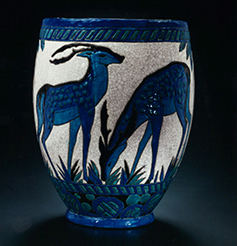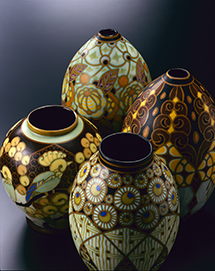Art nouveau
At the start of his career with Boch Frères, the pieces Charles Catteau created were rather traditional. He took his inspiration from the flora and fauna, in the style of Art Nouveau.
The acquisition of a style
After the First World War, Catteau put greater accent on incorporating his own ideas. Inspired by Art Deco, he began to look for innovation, progress and more contemporary effects. This influence became apparent in an increasingly marked choice of more stylised motifs, inspired by nature, as well as bold, bright colours.
He also began to repeat certain motifs. In the middle of the 1920s, the decoration on certain vases even came to resemble that seen on wallpaper: the entire surface was covered, so that it became a dense and decorative material. Later, Catteau experimented with the use of glazes on cloisonné pieces, bringing together the art of ceramics with that of glass.



Foreign influences
Thanks to Siegfried Bing and his Paris shop, as well as to the world fairs, artists came into contact with Japanese art. From then on, special attention began to be paid to the place of decoration on the shape. Simplicity became the watchword and enamelled colours served only to emphasise the overall look. Interest in linear and graphic decorative arts with clean lines grew. The figure sometimes became an instantly recognisable symbol, whilst elsewhere, a few brushstrokes were sufficient to generate a dynamic image.

Catteau applied the four basic principles of Japonisme with success and in perfect harmony with those of Art Deco: clean lines, strong, pure colours, decorative stylisation and balanced composition. In addition to Japonisme, Africanism, Ancient Greece and Egyptian culture all exerted an undeniable influence. Egyptomania was triggered in 1798 with Napoleon’s expedition to Egypt, but it was the discovery of Tutankhamen’s tomb in 1922 that this infatuation blossomed in an unprecedented manner. Formal and ornamental repertories having been rediscovered, Catteau tried to reconcile tradition and modernity.
Avant-garde movements such as cubism, abstraction and the Ballets Russes all influenced Catteau’s art. In line with these movements, he preferred incorporating the artistic tastes of his time in his work rather than creating large-scale, original pieces. Throughout his career, Catteau succeeded in combining his personal ambitions with his desire to disseminate art among the general public.